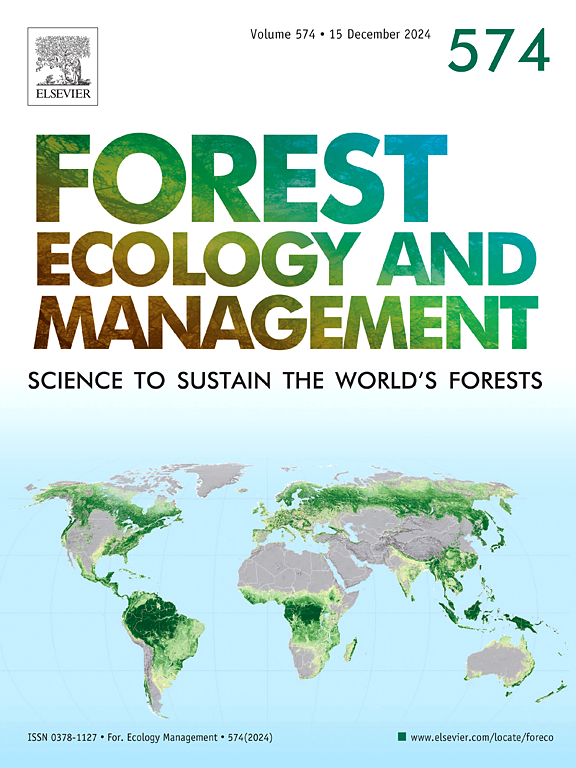美国新的异速生长模型在森林碳估算、建模和制图方面产生了转变
IF 3.7
2区 农林科学
Q1 FORESTRY
引用次数: 0
摘要
美国国家森林清查(NFI)是全国森林地上生物量(AGB)和碳核算的基础。这些数据使我们能够基于设计估算国家和区域层面的森林碳储量和储量变化,同时也为基于模型的方法提供输入,以更精细的时空分辨率表征森林碳储量和储量变化。尽管在这些模型中,NFI树和样地级数据通常被认为是真实的,但它们实际上是基于区域物种-群体模型和统称为成分比法(CRM)的参数的估计。2023年底,森林清册和分析(FIA)项目在全国范围内用新的国家规模体积和生物量估算(NSVB)系统取代了CRM,该系统提供了更精确和准确的森林AGB和碳表示。鉴于依赖于FIA的基于模型的AGB研究的流行,人们担心从CRM到NSVB模型的方法的可转移性,以及现有CRM AGB产品(例如地图)与新的和即将推出的NSVB AGB产品的可比性。为了开始解决这些问题,我们将以前发布的CRM AGB地图和估计与使用相同方法与NSVB AGB参考数据生成的新地图和估计进行了比较。我们的研究结果表明,依赖于被动卫星图像(例如Landsat)的模型提供了可接受的时间点NSVB AGB和碳储量的估计,但不能准确估计成熟或封闭冠层森林的生长。我们强调,基于FIA参考数据的现有估计、模型和地图不再与NSVB兼容,并建议采用新的方法以及更新的模型和地图来适应这种转变。我们在建模和制图工作流程中采用nsb的集体能力将帮助我们提供尽可能准确的空间森林碳数据,以便更好地为当地管理和决策提供信息。本文章由计算机程序翻译,如有差异,请以英文原文为准。
New allometric models for the USA create a shift in forest carbon estimation, modeling, and mapping
The United States national forest inventory (NFI) serves as the foundation for forest aboveground biomass (AGB) and carbon accounting across the nation. These data enable design-based estimates of forest carbon stocks and stock-changes at state and regional levels, but also serve as inputs to model-based approaches for characterizing forest carbon stocks and stock-changes at finer spatial and temporal resolutions. Although NFI tree and plot-level data are often treated as truth in these models, they are in fact estimates based on regional species-group models and parameters known collectively as the Component Ratio Method (CRM). In late 2023 the Forest Inventory and Analysis (FIA) program replaced CRM nationwide with a new National Scale Volume and Biomass Estimators (NSVB) system that offers more precise and accurate representations of forest AGB and carbon. Given the prevalence of model-based AGB studies relying on FIA, there is concern about the transferability of methods from CRM to NSVB models, as well as the comparability of existing CRM AGB products (e.g. maps) to new and forthcoming NSVB AGB products. To begin addressing these concerns we compared previously published CRM AGB maps and estimates to new maps and estimates produced using identical methods with NSVB AGB reference data. Our results suggest that models relying on passive satellite imagery (e.g. Landsat) provide acceptable estimates of point-in-time NSVB AGB and carbon stocks, but fail to accurately estimate growth in mature or closed-canopy forests. We highlight that existing estimates, models, and maps based on FIA reference data are no longer compatible with NSVB, and recommend new methods as well as updated models and maps for accommodating this shift. Our collective ability to adopt NSVB in our modeling and mapping workflows will help us provide the most accurate spatial forest carbon data possible in order to better inform local management and decision making.
求助全文
通过发布文献求助,成功后即可免费获取论文全文。
去求助
来源期刊

Forest Ecology and Management
农林科学-林学
CiteScore
7.50
自引率
10.80%
发文量
665
审稿时长
39 days
期刊介绍:
Forest Ecology and Management publishes scientific articles linking forest ecology with forest management, focusing on the application of biological, ecological and social knowledge to the management and conservation of plantations and natural forests. The scope of the journal includes all forest ecosystems of the world.
A peer-review process ensures the quality and international interest of the manuscripts accepted for publication. The journal encourages communication between scientists in disparate fields who share a common interest in ecology and forest management, bridging the gap between research workers and forest managers.
We encourage submission of papers that will have the strongest interest and value to the Journal''s international readership. Some key features of papers with strong interest include:
1. Clear connections between the ecology and management of forests;
2. Novel ideas or approaches to important challenges in forest ecology and management;
3. Studies that address a population of interest beyond the scale of single research sites, Three key points in the design of forest experiments, Forest Ecology and Management 255 (2008) 2022-2023);
4. Review Articles on timely, important topics. Authors are welcome to contact one of the editors to discuss the suitability of a potential review manuscript.
The Journal encourages proposals for special issues examining important areas of forest ecology and management. Potential guest editors should contact any of the Editors to begin discussions about topics, potential papers, and other details.
 求助内容:
求助内容: 应助结果提醒方式:
应助结果提醒方式:


